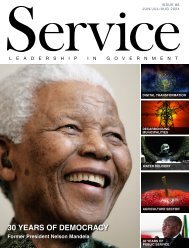Blue Chip Journal - June 2019 edition
Create successful ePaper yourself
Turn your PDF publications into a flip-book with our unique Google optimized e-Paper software.
CLIENT COACHING<br />
consider the level of risk they actually<br />
need to take to achieve a particular return<br />
or goal. But even a three-dimensional risk<br />
profile does not capture the complexity of<br />
a human being, particularly when it comes<br />
to money and a person’s relationship with<br />
money. Money goes to the core of our<br />
being as humans and can impact our lives<br />
hugely. Since the American Psychological<br />
Association’s annual “Stress in America”<br />
survey began in 2007, money consistently<br />
has been the top stressor for Americans.<br />
Coach your clients<br />
and they won’t make<br />
poor decisions<br />
Human complexity is evident in<br />
the drivers of investor behaviour<br />
This complexity is evident when we<br />
consider what actually drives investor<br />
behaviour. Often we think it is simply<br />
the emotions of greed and fear. They<br />
certainly play a role. But our minds are<br />
also problematic. Research suggests<br />
we are prone to over 180 cognitive<br />
biases that can influence our thinking<br />
and decision-making. Organisational<br />
psychologist Herbert Simon coined the<br />
term “bounded rationality” to describe<br />
our limits with respect to how we think<br />
and make decisions.<br />
To compound matters, as Daniel<br />
Kahnemann points out in his book<br />
Thinking Fast and Slow, we have two<br />
brains, intuitive (fast) and reflective<br />
(slow). The reality is that our brains are<br />
lazy and like to take short cuts wherever<br />
possible. These short cuts are often<br />
driven by our intuitive brains, which<br />
always look for the most obvious and<br />
quickest solution. The problem is our<br />
intuitive brain responds to immediate<br />
triggers like falling markets or hungry<br />
lions, and in some instances we make<br />
good decisions, like running away from<br />
the lion, but in other situations we make<br />
bad decisions, like selling investments<br />
when they are cheap.<br />
Apart from our emotions and our<br />
minds, which neuroscience suggests are<br />
inextricably linked, a third influence on<br />
our behaviour and decision-making is<br />
other people. As social beings, humans are<br />
susceptible to social pressure. This is often<br />
a key driver of poor investor behaviour.<br />
Investors love to compare the performance<br />
of their investments. Or take the advice of<br />
family, friends, colleagues and the media.<br />
These are then used as ammunition<br />
to challenge a financial advisor’s<br />
advice or perspective.<br />
Behavioural coaching can<br />
help advisors handle their<br />
clients’ complexity<br />
It is no surprise, given the complexity<br />
of human beings, that to<br />
overcome poor investor behaviour<br />
is a challenge. It explains why reputable<br />
investment businesses like Vanguard and<br />
Morningstar suggest that the most significant<br />
value that a financial advisor offers<br />
is behavioural coaching. US financial<br />
advisor and author of the book Behavioural<br />
Investment Counseling, Nick Murray,<br />
believes that this value equates to Dalbar’s<br />
behaviour penalty of 5%. He tells clients<br />
that 80% of his value to them is coaching<br />
them through the market's ups and downs.<br />
The other 20% is helping them put a plan<br />
in place and developing a strategy to fund<br />
that plan. The coaching helps the clients<br />
stick to the plan.<br />
The message seems clear. To overcome<br />
the challenge of investor behaviour, coach<br />
your clients and they won’t make poor<br />
decisions. Easier said than done, particularly<br />
since financial advisors are human<br />
themselves, and many poor decisions by<br />
investors are in fact advised decisions.<br />
The path of least resistance<br />
perpetuates the investor<br />
behaviour problem<br />
My experience of working with financial<br />
advisors is that often they take the path<br />
of least resistance. If the client compares<br />
performance, complains, or is just grumpy<br />
about their investment, the temptation<br />
for the advisor is to do something to<br />
make them happy again. Unfortunately<br />
this happiness is short term. Deviation<br />
from a long-term strategy for short-term<br />
happiness simply provides Dalbar with<br />
another statistic to show how investors<br />
underperform on their investments.<br />
As any coach will tell you, no matter<br />
the context, coaching is tough. It means<br />
challenging your client. Pointing out where<br />
they are making flawed assumptions.<br />
Highlighting where they are not sticking<br />
to commitments or taking personal<br />
responsibility. A friend of mine who is an<br />
executive coach tells his clients that they<br />
will have a “fight” in their third or fourth<br />
meeting and only if they get through that<br />
will the relationship be able to continue.<br />
The path of least resistance is not the<br />
path to achieving goals. Being personable<br />
is not enough to overcome the challenge of<br />
investor behaviour. Engaging clients with a<br />
coaching way of being and then dispensing<br />
sound expert advice is what is needed.<br />
Unfortunately, until now, the focus of advisor<br />
training has been on expert advice. I believe<br />
we will only overcome the challenge of poor<br />
investor behaviour through real human<br />
connection and the development of genuine<br />
behavioural coaching skills.<br />
References<br />
Dalbar Quantitative Analysis of Investor<br />
Behaviour, 2015<br />
American Psychological Association, “Stress<br />
in America” Surveys, 2007-2018.<br />
Rob Macdonald, Fundhouse<br />
54 www.bluechipjournal.co.za


















